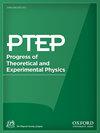High-pressure xenon gas time projection chamber with scalable design and its performance at around the Q value of 136Xe double-beta decay
IF 8.3
4区 物理与天体物理
Q1 Physics and Astronomy
引用次数: 0
Abstract
We have been developing a high-pressure xenon gas time projection chamber (TPC) to search for neutrinoless double beta (0νββ) decay of 136Xe. The unique feature of this TPC is in the detection part of ionization electrons, called ELCC. ELCC is composed of multiple units, and one unit covers 48.5cm2. A 180L size prototype detector with 12 units, 672 channels, of ELCC was constructed and operated with 7.6bar natural xenon gas to evaluate the performance of the detector at around the Q value of 136Xe 0νββ. The obtained FWHM energy resolution is 0.73+-0.11% at 1836keV. This corresponds to 0.60+-0.03% to 0.70+-0.21% of energy resolution at the Q value of 136Xe 0νββ. This result shows the scalability of the AXEL detector with ELCC while maintaining high energy resolution. Factors determining the energy resolution were quantitatively evaluated and the result indicates further improvement is feasible. Reconstructed track images show distinctive structures at the endpoint of electron tracks, which will be an important feature to distinguish 0νββ signals from gamma-ray backgrounds.采用可伸缩设计的高压氙气时间投影室及其在136Xe双β衰变Q值附近的性能
我们一直在开发一种高压氙气时间投影室(TPC)来寻找136Xe的中微子双β (0νββ)衰变。这种TPC的独特之处在于电离电子的检测部分,称为ELCC。ELCC由多个单元组成,一个单元占地48.5㎡。构建了一个180L尺寸的ELCC原型探测器,12个单元,672个通道,并在7.6bar的天然氙气中运行,以评估探测器在Q值136Xe 0νββ附近的性能。在1836keV下得到的FWHM能量分辨率为0.73+-0.11%。这相当于136Xe 0νββ Q值的能量分辨率的0.60+-0.03%至0.70+-0.21%。这一结果显示了ELCC在保持高能量分辨率的同时,AXEL探测器的可扩展性。对影响能量分辨率的因素进行了定量评价,结果表明进一步改进是可行的。重建的轨道图像在电子轨道端点处显示出独特的结构,这将是区分0νββ信号与伽马射线背景的重要特征。
本文章由计算机程序翻译,如有差异,请以英文原文为准。
求助全文
约1分钟内获得全文
求助全文
来源期刊

Progress of Theoretical and Experimental Physics
PHYSICS, MULTIDISCIPLINARY-PHYSICS, PARTICLES & FIELDS
CiteScore
12.00
自引率
5.70%
发文量
148
审稿时长
17 weeks
期刊介绍:
Progress of Theoretical and Experimental Physics (PTEP) is an international journal that publishes articles on theoretical and experimental physics. PTEP is a fully open access, online-only journal published by the Physical Society of Japan.
PTEP is the successor to Progress of Theoretical Physics (PTP), which terminated in December 2012 and merged into PTEP in January 2013.
PTP was founded in 1946 by Hideki Yukawa, the first Japanese Nobel Laureate. PTEP, the successor journal to PTP, has a broader scope than that of PTP covering both theoretical and experimental physics.
PTEP mainly covers areas including particles and fields, nuclear physics, astrophysics and cosmology, beam physics and instrumentation, and general and mathematical physics.
 求助内容:
求助内容: 应助结果提醒方式:
应助结果提醒方式:


